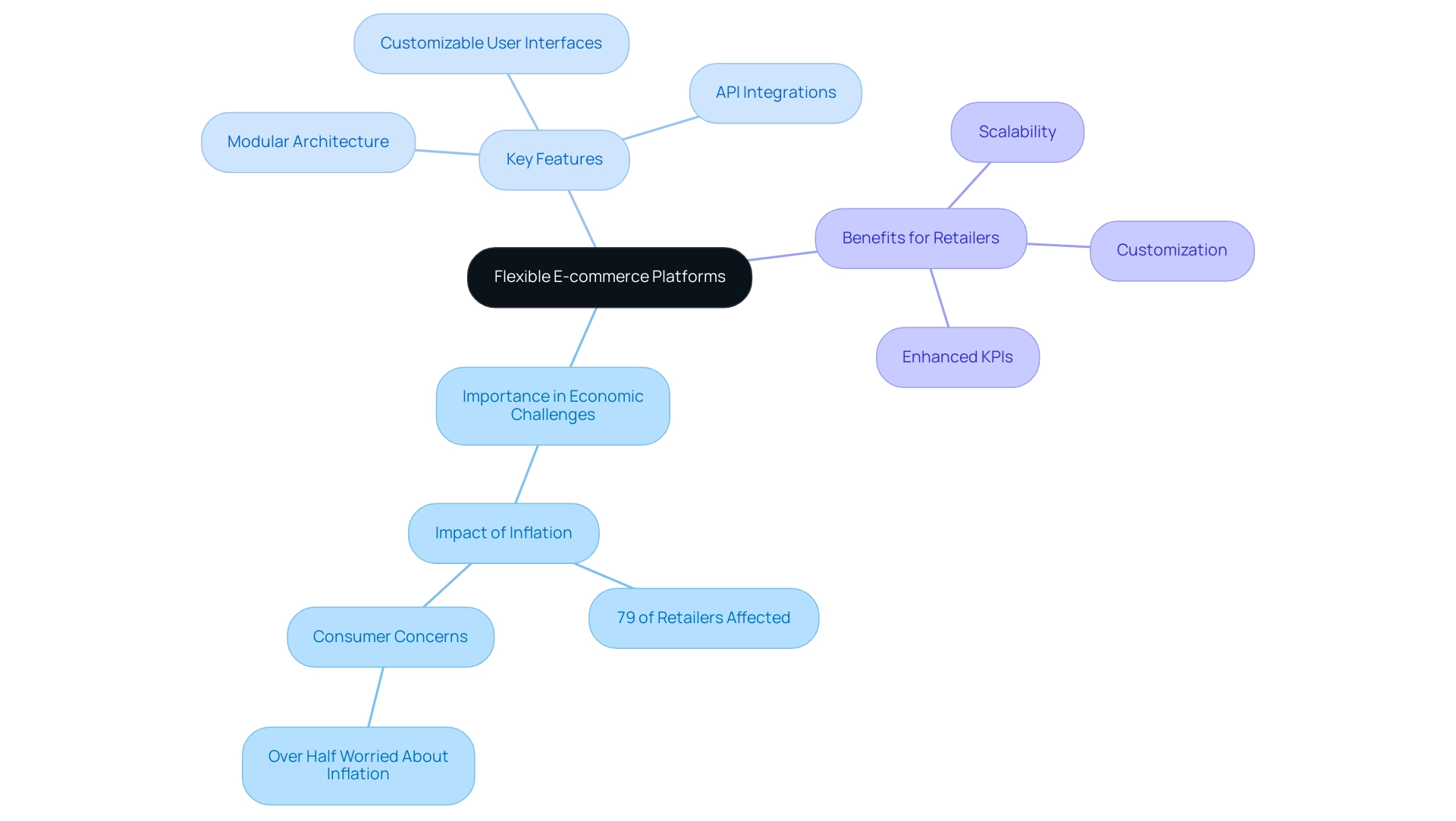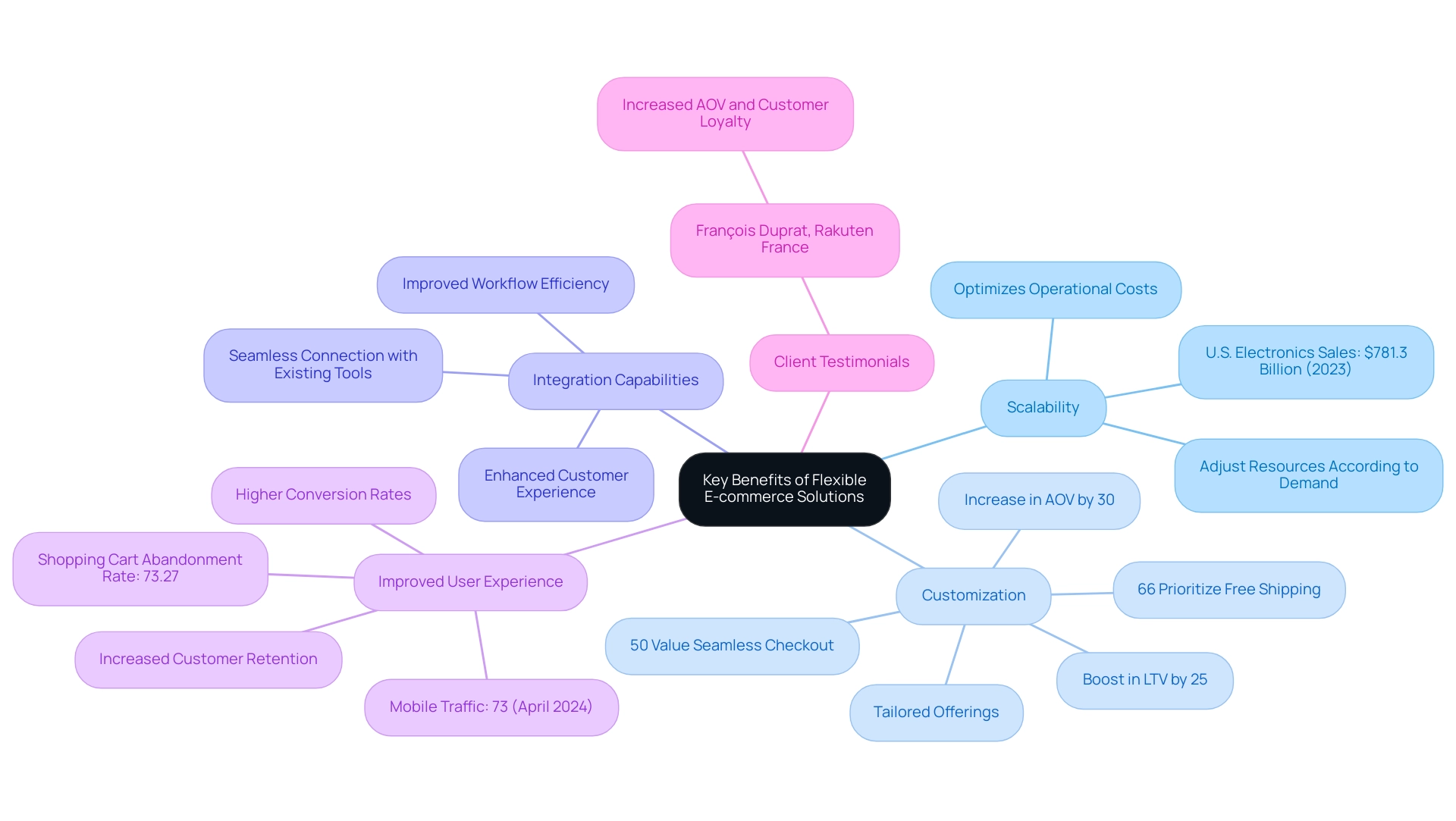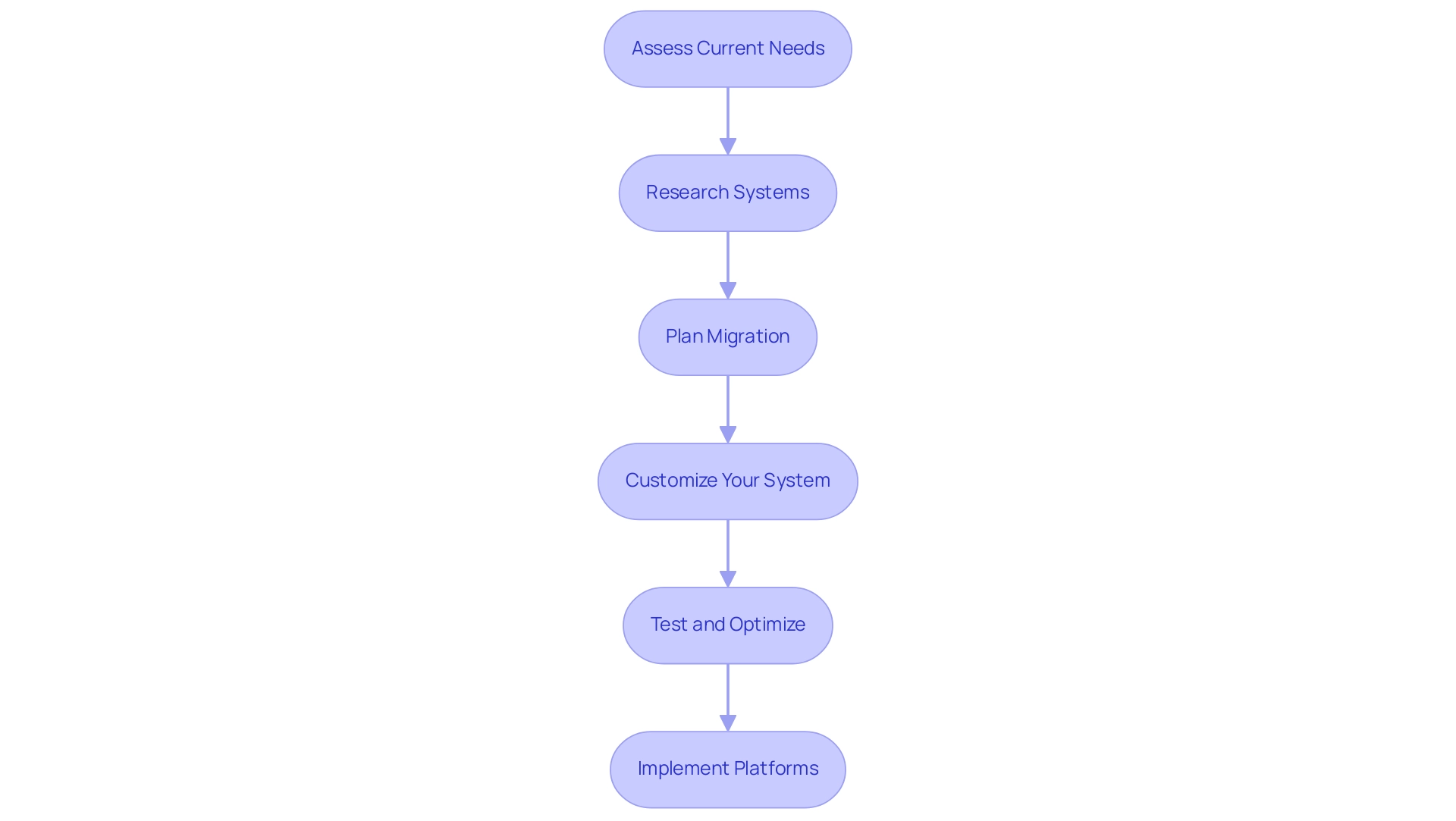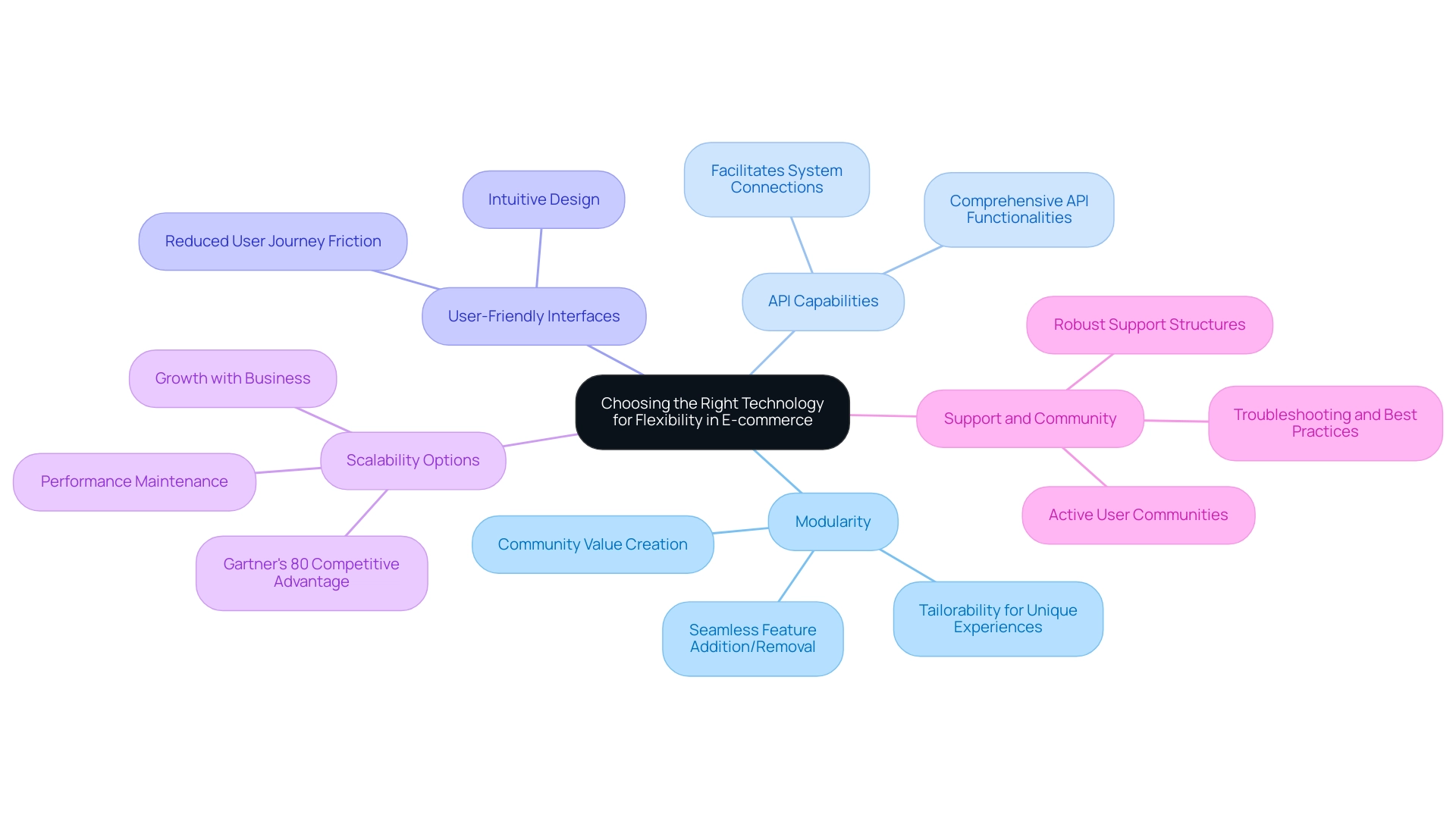Introduction
In a rapidly evolving digital marketplace, the ability to adapt is no longer just an advantage; it's a necessity. Flexible e-commerce platforms are at the forefront of this transformation, providing businesses with the agility needed to respond to economic fluctuations and shifting consumer behaviors.
As inflation and market dynamics reshape the retail landscape, organizations must embrace solutions that not only enhance operational efficiency but also improve customer engagement and drive revenue growth.
This article delves into the critical role of flexible e-commerce platforms, exploring their key benefits, implementation strategies, and essential technology considerations that empower businesses to thrive amidst uncertainty.
By understanding and leveraging these adaptable systems, companies can position themselves for long-term success in an increasingly competitive environment.
Understanding Flexible E-commerce Platforms
Versatile online marketplaces are crucial in navigating today’s dynamic market environment, particularly as economic challenges such as inflation alter consumer behavior and retailer strategies. Notably, 79% of American retailers feel the effects of inflation, underscoring the need for adaptability in their operations. These systems stand in contrast to traditional models, which can often be rigid and resistant to modification.
Implementing flexible e-commerce platforms not only facilitates customization, scalability, and seamless integration with other technologies but also aligns directly with our proven track record of enhancing KPIs for our clients. By supporting various models, these platforms enable companies to pivot quickly in response to evolving market trends and customer expectations, ultimately building incremental revenue by optimizing sales processes and enhancing customer engagement. Our customized offerings, supported by more than 20 years of worldwide experience, guarantee organizations cultivate community value and resilience.
Key elements of flexibility include:
- Modular architecture, which allows for easy updates and changes
- API integrations that facilitate connectivity with other systems
- Customizable user interfaces
As noted by Nebojsa Radakovic, 'The simplest definition of headless commerce is that it is an eCommerce approach where the webshop frontend and the backend are decoupled.' This decoupling enables companies to improve their online presence and operational efficiency while adapting to economic pressures.
The case study named 'Economic Challenges Impacting E-Commerce' illustrates how enterprises are implementing flexible e-commerce platforms to navigate inflation and market changes, showcasing the tangible advantages of customized approaches in ensuring resilience and adaptability in an ever-changing economic environment.

Key Benefits of Flexible E-commerce Solutions
Implementing flexible e-commerce platforms presents numerous advantages that can significantly enhance a brand's market position. One of the foremost benefits is scalability, allowing businesses to adjust their resources according to fluctuating demand. This capability ensures that companies only invest in what they require, optimizing operational costs.
In the vast U.S. online retail landscape, where electronics alone generated $781.3 billion in sales in 2023, the ability to scale efficiently is crucial for maintaining competitiveness. Furthermore, the popularity of pharmacy products and fashion in Sweden, both with a 42% purchase rate, emphasizes varied consumer behaviors that require flexible approaches.
Moreover, customization is a vital component of modern e-commerce platforms. Our customized offerings, shaped by over 20 years of global experience, are designed to meet specific customer needs, enhancing satisfaction and fostering loyalty. Research indicates that 66% of consumers prioritize features like free shipping, and 50% recognize the importance of a seamless checkout process in their shopping experience.
Thus, a customized user interface can significantly enhance engagement and conversion rates. Specifically, companies employing our offerings have reported an increase in Average Order Value (AOV) by up to 30% and a 25% boost in Lifetime Value (LTV) through personalized shopping experiences.
The integration capabilities of adaptable systems further streamline business operations. By seamlessly connecting with existing tools such as CRM systems and payment gateways, companies can create a more efficient workflow, ultimately facilitating a superior customer experience. Our solutions have a proven track record of significantly improving critical KPIs, including retention rates and Average Order Value (AOV), contributing to incremental revenue growth for our clients.
Lastly, the focus on improved user experience cannot be overstated. A customizable system can transform the shopping journey, resulting in higher conversion rates and increased customer retention. As mobile traffic to e-commerce sites surged to 73% in April 2024, businesses must adapt their platforms to cater to this trend effectively.
This adaptation is critical, especially considering that the global average shopping cart abandonment rate stands at 73.27%, underscoring the challenges retailers face in converting potential sales into completed transactions. By tackling these challenges with adaptable approaches, companies can better meet consumer expectations and enhance community value by implementing flexible e-commerce platforms.
Client testimonials further illustrate our success:
- "The tailored approaches offered by this team increased our AOV significantly, and we've seen a notable rise in customer loyalty since implementing their recommendations," says François Duprat, Head of Product at Rakuten France.
By embracing these strategic advantages, companies can carve out a competitive edge in the increasingly crowded online marketplace. Success stories of tailored online commerce solutions demonstrate that the right approach not only meets consumer expectations but also drives long-term growth.

Step-by-Step Guide to Implementing Flexible E-commerce Platforms
-
Assess Current Needs: Begin by conducting a thorough evaluation of your existing online commerce infrastructure. Identify specific areas where flexibility is crucial, taking into account factors such as traffic patterns, product diversity, and the demographics of your customer base. Understanding these elements is essential, especially considering that sectors like health and beauty currently have an average conversion rate of just under 3%. As Natalia Bohdanets, Marketing Manager at MagneticOne, emphasizes, "Understanding your unique needs is crucial for effective online commerce migration." Our customized online commerce solutions, backed by over 20 years of global experience, are designed to enhance these critical KPIs for your organization, including retention rates, Average Order Value (AOV), and Lifetime Value (LTV).
-
Research Systems: Engage in comprehensive research on implementing flexible e-commerce platforms. Compare key features, pricing structures, and user reviews to determine which platform aligns best with your goals. Notable options include Shopify, WooCommerce, and Magento, each offering distinct advantages based on your operational needs. Our solutions have a proven track record of assisting companies in boosting Average Order Value (AOV) and increasing Lifetime Value (LTV).
-
Plan Migration: Formulate a detailed migration plan that encompasses timelines, required resources, and anticipated challenges. A robust strategy is vital for ensuring a smooth transition, particularly in light of the average conversion rate across all e-commerce sectors being around 2%. The case study titled "Health and Beauty Sector Conversion Rates" demonstrates how enterprises that optimize their systems can significantly improve their conversion rates and enhance community value.
-
Customize Your System: Collaborate with experienced developers to tailor the chosen system to meet your specific business requirements. Customization may involve designing user interfaces, enhancing functionalities, and integrating third-party tools that streamline operations and improve user experience. Our custom solutions have transformed industries and are designed to address the unique requirements of content publishers, charities, and conventional online businesses, aligning directly with your internal objectives and KPIs.
-
Test and Optimize: Prior to launching, engage in comprehensive testing to confirm that all components function seamlessly. Collect user feedback and implement necessary optimizations to improve the system's performance. Continuous improvement is key to maximizing conversion rates, which are particularly critical in the competitive health and beauty sector.
-
Once you have finalized testing and optimization, proceed with implementing flexible e-commerce platforms for your new online shopping solution. Post-launch, maintain vigilance by continuously monitoring performance metrics. This ongoing analysis will allow you to make timely adjustments, ensuring your online business solution remains competitive and responsive to market demands while delivering incremental revenue and community value.

Choosing the Right Technology for Flexibility in E-commerce
When choosing technology for your adaptable online business system, several essential factors should inform your decision-making process:
- Modularity:
Prioritize systems with a modular architecture, enabling you to seamlessly add or remove features in response to evolving organizational needs. This adaptability is crucial in today’s fast-paced market and allows for tailorability in creating unique experiences for your customers.
Our e-commerce offerings, refined through 20 years of experience in over 20 countries, focus on creating community value alongside organizational objectives, which directly improves key performance metrics such as retention rates, Average Order Value (AOV), and Lifetime Value (LTV).
-
API Capabilities:
Robust API integration is essential.
Ensure the system supports comprehensive API functionalities that facilitate connections with other systems and tools, fostering a more cohesive technological environment. -
User-Friendly Interfaces:
Opt for technologies that deliver intuitive user interfaces, enhancing the experience for both customers and administrators.
A well-designed interface can significantly reduce friction in the user journey. -
Scalability Options:
Choose solutions that can grow alongside your business, accommodating increases in traffic and product offerings without sacrificing performance.
According to Gartner, organizations embracing a composable approach will outpace their competitors by 80% when implementing new features. -
Support and Community:
Select platforms with robust support structures and active user communities.
These resources are invaluable for troubleshooting and sharing best practices, which can enhance the overall effectiveness of your online business operations.
A case study illustrating this is Commercetools, which offers a headless solution available as a SaaS on Google Cloud or Amazon Web Services. Their modularity allows for an agile infrastructure, although integration requires experienced development teams, making it suitable for large organizations with significant resources.
By making informed technology choices, organizations can harness the full potential of flexibility through implementing flexible e-commerce platforms, ensuring sustained success in the evolving e-commerce landscape. Remember, technology should be an enabler to the objectives of an organization, not the goal itself—a philosophy that emphasizes strategic alignment in tech adoption. Additionally, our solutions are designed to build incremental revenue for your organization by helping your users win, further enhancing your overall business performance.

Conclusion
Flexible e-commerce platforms have emerged as a vital asset for businesses aiming to navigate the complexities of today's economic landscape. As highlighted, these platforms provide crucial benefits such as scalability, customization, and seamless integration, allowing companies to adapt quickly to changing consumer demands and market conditions. This adaptability is not merely a competitive edge; it is essential for maintaining relevance and efficiency in an increasingly crowded marketplace.
The step-by-step guide to implementing these platforms underscores the importance of:
- Thorough assessment
- Strategic planning
- Continuous optimization
By carefully evaluating current needs and selecting the right technology, organizations can create tailored solutions that significantly enhance user experience and drive revenue growth. The emphasis on modularity, API capabilities, and user-friendly interfaces further reinforces the necessity of choosing the right tools to support business objectives.
Ultimately, embracing flexible e-commerce solutions positions businesses not only to survive but to thrive amidst uncertainty. By leveraging these adaptable systems, organizations can enhance customer engagement, optimize operational efficiency, and secure long-term success in an ever-evolving digital marketplace. The time to act is now—prioritizing flexibility will empower businesses to forge ahead, ensuring resilience and sustained growth in the face of economic challenges.





